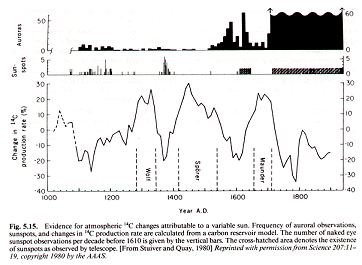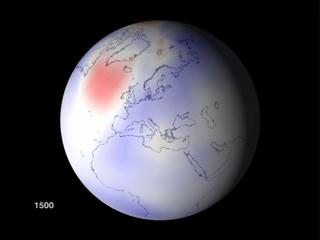
Global Temperature Changes Throughout the History
| The most recent glacial event known as the Pleistocene Epoch Ice Age ended 10,000 years ago. It was a time of extreme global temperature change, and a time when ice sheets covered much of the Earth’s surface- it was a difficult and harsh environment to live in. Today, we no longer live in an Ice age, and may think that global temperature change is so mild that it barely affects us. This however, is not true. Although it may seem that global temperature remains fairly constant, yet we still undergo warmer and cooler periods in the course of human history. Below is a graph showing the temperature change in the last millennium: |  |
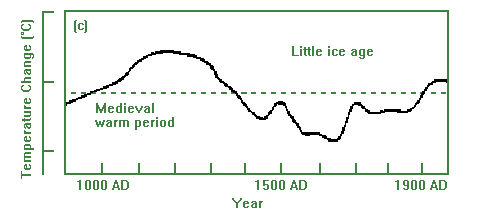
Medieval Warm Period
Earth is currently in a warm interglacial period called the Holocene that began around 10,700 years ago. During the Holocene, there have been about seven major warming and cooling trends, some lasting as long as 3000 years, others as short as 650. The most recent warm period is the medieval warm period (~1000-1300 A.D.).
History has shown that global warming is a good thing. At the warmest the Earth has been during the Holocene, generally referred to as the Holocene Maximum (~6500-3500 B.C.), agricultural revolution began in the Middle East, laying the foundation for civilization.
| During the Medieval Warm Period:
- End of Dark Ages - Iceland and Greenland were settled (probably first by the Vikings) - Retreat of Arctic sea ice - Wine grapes harvested in England - Higher tree lines in the Alps |
 |
The Medieval Warm Period should have corresponded to an increase in sunspots activity, large number of sunspots and high frequency and intensity of aurora should have been observed at that period of time. Records of sunspots were not compounded, as people at that time have not come to realize the significances of sunspots. However, using recent technology-by examining the carbon-14 concentration in the atmosphere at that period of time-the extent of sunspots activity can be estimated.
Observing Solar Minima and Maxima: Concentration of Atmospheric Carbon-14
| Carbon-14, an isotope of the element carbon, is produced in the Earth's lower stratosphere by the collision of neutrons, produced by cosmic rays, with nitrogen. (An isotope is made up of atoms of the same element but with different numbers of neutrons.) During periods of high sunspots activity, the solar wind prevents charged particles from entering the atmosphere, thus producing little carbon-14. However, carbon-14 production peaks during the solar minima, and it enters the Earth's troposphere as carbon dioxide-14. Trees for photosynthesis, absorb carbon dioxide- hence, by studying the concentration of carbon-14 in trees, it is possible to estimate the extent of sunspots activity at a particular time period. Another method of estimating sunspots activity is by studying the dust concentration in ice core from remote places like in Greenland. There is known correspondence between atmospheric dust level and sunspots activity. | 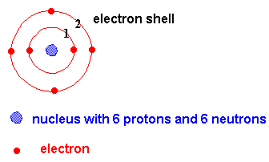 |
Little Ice Ages
The little ice ages (~1450-1890 A.D.) were not a true ice age - ice sheets did not grow. This followed the medieval warm period and Earth’s climate is generally cooler during this time. During this period, however:
|
-> Glaciers advanced in almost all alpinee regions - the Alps, the Sierra Nevada and Rocky Mountains, eastern Africa, the Himalayas, New Guinea, the southern Andes, and New Zealand
-> Records from fur trappers indicate that freezing dates and Moose Factory at the southern shores of James Bay (southern Hudson Bay) were a week earlier and break-up dates 10 days to 2 weeks later -> Sea-ice advance in the North Atlantic -> Severe losses of livestock and famines in Scotland -> Shelley writes Frankenstein; Polidori writes The Vampire-in 1816, "the year without a summer" -> Eskimos seen off the coast of England -> Crop yields fell during the little ice ages |
 |
Artistic portraits showing the frozen rivers during the "Year without a summer" in 1816 A.D.:


During the "Wolf Minimum", the "Sporer Minimum" as well as the most recent little ice age, the "Maunder Minimum", are periods of time when atmospheric carbon-14 concentration was high, which corresponded to a period of low sunspots activity, a time when sunspots rarely occurred. The Medieval Warm Period, on the other hand, corresponded to a period of high solar activity; a time when sunspots occurred in abundance. Therefore, the relationship of the Earth’s climate change to sunspots activity is intimately related.
Other Speculations Behind the Earth's Climate Change
| Recent report by NASA Earth Observatory dated June 11, 2002, suggested that there is a very close correlation between major volcanic eruptions and cooling of the Earth’s climate. The "Year without a summer" occurred after three major volcanic eruptions: Soufriere on St. Vincent Island erupted in 1812; Mayon in the Philippines in 1814; and Tambora on the island of Sumbawa in Indonesia in 1815. However, prolonged periods (relative to a human’s lifespan) of warmer and cooler climate of the Earth’s which may last a hundred to a thousand of years cannot be explained by the volcanic activity of the Earth’s alone. These periods are known as the "short term" climate change as "long term" climate change spans over millions of years. |  |
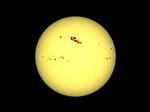 |
The sunspots cycle we are talking about is on average about 11 years long, while a complete cycle of the Sun for it to return to its original magnetic state is 22 years long-therefore, two 11 years cycles (repetitive cycles confirmed by the scientists). So, how do we explain the medieval warm period, which lasted for about 300 years and the little ice ages that all together lasted for about 400 years? And how about the "long term" climate change that purges the world into the true ice age, which lasts millions of years? Can sunspots really explain the change in Earth’s climate? |
The Green House gases are now the prime suspects for the current global warming. However, is the Earth really warmer now than before? As a matter of fact, for the past 7,500 of the last 10,000 years, the Earth’s temperature was higher than today!
To understand the extended period of the Earth’s climate change, we have to explore a larger cycle of the sunspots activity. This at the moment is beyond our capacity to interpret. Well, there are still many other theories that can explain the rise and fall in temperature of the Earth, but lets not look further than the sun, our source of heat energy, 93 million miles away!
Geology 150 - Climate Changes
SVS Ice Age Science Story 20011207
UniSci, Of Sunspots, Volcanic Eruptions And Climate Change
Environment & Climate News: Global temperature changes throughout history
Hartwick College Geology Department, Ice Ages and Glaciation
http://wchs.csc.noaa.gov/1816.htm
Coalition for Vehicle Choice, Little Ice Age
newswise, Carbon-14
The National Center for Public Policy Research, Global Warming: Enjoy it While You Can
The Live Wire, The Blame for Global Warming May Lie 93 Million Miles Away
Catastrophic Weather and Climatic Change, Mechanisms of Climate Change
Page © of GEM1506K, Group 2 (http://www.oocities.org/sg/apollonus02)
